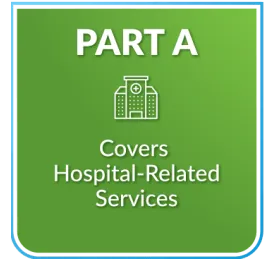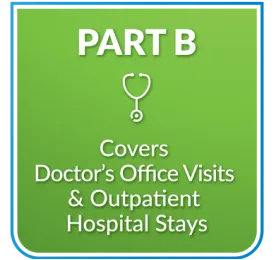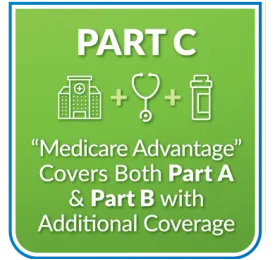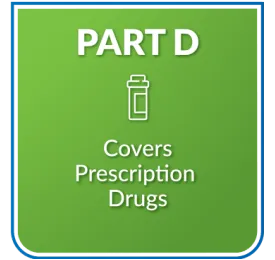Medicare Guidance Made Simple with Support You Can Trust
Personalized, one-on-one Medicare help for seniors 65+, whether you're in Kentucky or across the country — with no cost, no pressure, and a promise to make things easy.
Part B – Medical insurance




Medicare Part B is the medical insurance portion of Medicare. It covers medically necessary services and supplies that are essential for diagnosing and treating health conditions. This includes outpatient care, preventive services, ambulance transportation, and durable medical equipment. Part B may also cover part-time home health care and rehabilitative services such as physical therapy.
Medicare Part B covers:
Medically necessary services:
Services or supplies needed to diagnose or treat a medical condition, in accordance with accepted standards of medical practice.
Preventive services:
Health care aimed at preventing illness (such as flu shots) or detecting conditions early, when treatment is most effective.
Costs for Preventive Services
You typically pay nothing for most preventive services if you receive them from a health care provider who accepts Medicare assignment (agrees to be paid directly by Medicare and not charge more than the Medicare-approved amount).
Medicare Part B Covers:
Clinical research
Coverage for approved clinical trials to help diagnose or treat a medical condition.
Limited Outpatient Prescription Drugs
Only certain medications administered in outpatient settings, such as injections or chemotherapy drugs.
Mental Health Services
Inpatient care (covered under Part A, but coordinated with Part B)
Outpatient care, including therapy and counseling
Partial hospitalization programs
Ambulance Services
Emergency and, in some cases, non-emergency medical transportation when other transportation could endanger your health.Durable Medical Equipment (DME)
Medically necessary equipment such as wheelchairs, walkers, oxygen equipment, and hospital beds.
Part B Medicare insurance coverage is based on the following factors:
Federal laws – Set the overall framework for Medicare coverage.
State laws – May affect what services can be provided and who can deliver them.
National Coverage Determinations (NCDs) – Decisions made by Medicare at the federal level about whether a service or item is covered.
Local Coverage Determinations (LCDs) – Made by Medicare Administrative Contractors (MACs), these decisions specify coverage in particular geographic areas.
Medicare Part B Costs
Most U.S. citizens are automatically enrolled in Medicare Part B when they become eligible. Others may need to manually sign up if they’re not receiving qualifying benefits.
Monthly Premiums
Most U.S. citizens are automatically enrolled in Medicare Part B when they become eligible. Others may need to manually sign up if they’re not receiving qualifying benefits.
Social security
Railroad retirement board
Personnel management office
If you're not receiving any of these benefits, you’ll receive a monthly bill to pay your Part B premium manually.
2020 Premium Example
Most people pay the standard premium amount, but if your modified adjusted gross income (MAGI) is above a certain threshold, you may have to pay an additional income-related monthly amount.
In 2020, the standard Medicare Part B premium was $144.60 per month. (Note: This amount is typically updated annually.)
Medicare Part B Enrollment
If you begin receiving retirement benefits before age 65, or if you qualify for Medicare due to a disability, you will be automatically enrolled in both Medicare Part A and Part B when you become eligible.
Enrollment Periods
Initial Enrollment Period (IEP)
This is a 7-month window that begins 3 months before the month you turn 65 and ends 3 months after your birthday month.
You should enroll during this period to avoid delays in coverage or potential penalties.Special Enrollment Period (SEP)
If you miss your initial enrollment but qualify (e.g., you're still working and have employer coverage), you may enroll later without penalties.
General Enrollment Period (GEP)
If you don’t qualify for a Special Enrollment Period and miss your IEP, you can enroll during the General Enrollment Period, which runs from January 1 to March 31 each year.
Coverage begins on July 1.
How to Enroll
If you are not automatically enrolled, you can apply for Medicare Part B by:
Visiting the Social Security website: ssa.gov
Calling Social Security at +1 (606) 492-7664 (Monday to Friday)
Applying in person at your local Social Security office
Medicare Supplement (Medigap) Enrollment
Once you enroll in Medicare Part B, your 6-month Medigap Open Enrollment Period begins. During this time:
You have a guaranteed right to buy any Medicare Supplement (Medigap) plan offered in your state.
You cannot be denied coverage or charged a higher premium based on your health.
This is the best time to purchase a Medigap plan—don't miss it!
Medicare Part B Eligibility
Anyone eligible for Medicare Part A is qualified for Medicare Part B by enrolling and paying a standard monthly premium. And if you are not able for Medicare Part A, you can also qualify for Medicare Part B by meeting the following criteria:
You reached ta the age of 65 years or older.
You are a U.S. citizen.
You are a permanent resident residing in the U.S. for at last five continuous years.
You may also qualify for automatic Medicare Part B enrollment if you are a disabled person. Or if you are under 65 years of age and getting social security benefits, you will automatically get enrolled in Medicare Part B after 24 months of disability benefits. You will also get Medicare Part B insurance enrollment before 65 if you experience last-stage renal disease or amyotrophic lateral sclerosis.
Medicare Part B Premiums
Your Medicare Part B premiums can change from year to year, and cost can vary based on your situation. For many people, it is deducted automatically from their social security benefits.
The monthly Part B premium is $144.60 in 2020.
But if your income exceeds a certain amount, your premium may also increase than the standard premium, as there are different premiums for different income levels in Medicare part B.
If you don’t get social security or rail board benefits, you’ll get a bill to pay your premiums:
Part B for medical insurance
Part A for hospital insurance


